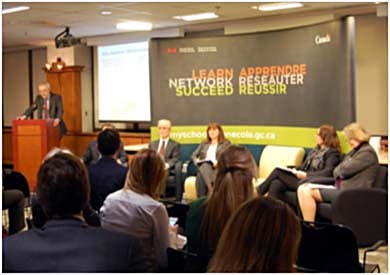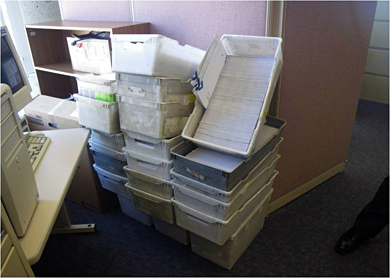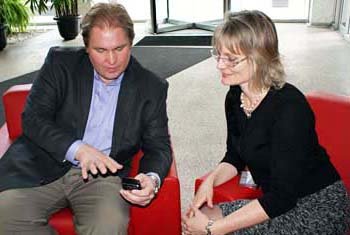See the vision in practice: We are already living the vision
Feature 1
Open collaboration and open data
The Federal Geospatial Platform
What is it?
The Government of Canada has a wealth of location-based (known as “geospatial”) information and expertise. This is a huge asset in the digital age where data is the new global currency. The Federal Geospatial Platform will be a collaborative online environment where the government’s most relevant geospatial information can be found easily and viewed on maps to support decision-making, foster innovation and provide better service for Canadians. The Platform will fundamentally change the way government shares, uses and manages its geospatial information.
Why is it important?
Harnessing the government’s geospatial information is essential to setting the stage for longer term transformation. As the Platform is phased into operation, expected to begin in 2014, it will play a key role in bringing together the government’s economic, social and environmental data to better support location-based decision-making on a range of complex issues, such as responsible resource development, environmental management, regulatory reviews, and safety and security.
For example, if a new mine was undergoing a regulatory review, the Platform would provide government analysts, stakeholders, and citizens with a clearer picture of all the factors at play in the decision making process.
The Platform would allow an interested party to see the new mining development on a regional map with other relevant information, including employment and economic growth data for the area, local infrastructure such as accessible ports and communities near the mine, and important environmental information at play such as sensitive wildlife areas and park boundaries.
“The Federal Geospatial Platform is an excellent example of a transformative initiative that supports Blueprint 2020. It is a collaborative effort across 21 departments and agencies that will help move the Public Service towards a modern, techenabled organization that manages its geospatial assets more effectively to support policy priorities.
”
– David Harper, Earth Sciences Sector, Natural Resources Canada
This would enable complex ideas to be communicated more clearly and help support informed and transparent decision making.
The Platform will also help on the safety and security front, enabling the production of innovative and practical applications, such as real-time disaster maps for Canada that will help save lives.
The Platform will drive innovation and stimulate economic development as well. By making our geospatial information available in a coherent way to the public, academia, the private sector and others, it can be used more effectively to support research or facilitate the development of value-added products and applications. This aligns with Canada’s Action Plan on Open Government.
As a government-wide solution, the Platform will also increase operational efficiencies and internal productivity within the Public Service, a key priority of the Government.
What were key factors in moving forward?
Many departments and agencies make significant investments to collect and manage their geospatial information, but for various reasons, barriers exist that prevent the timely sharing and integration of this information across the federal family and with partners. Working together across government, the Federal Committee on Geomatics and Earth Observations (FCGEO) has been working to break down these barriers and capitalize on the full potential of the government’s geospatial information through the Platform initiative.
The FCGEO represents 21 federal departments and agencies that are producers and/or consumers of geospatial data that are voluntarily collaborating in this broad federal effort. They have adopted an inclusive, open and transparent approach with each other in the interest of not just the federal government, but for the benefit of all Canadians. Recognition of the power and potential of new technologies and media, and of the importance of authoritative, open data to Canada’s knowledge economy and global competitiveness was also key to moving this initiative forward.
Feature 2
Simpler, more accessible services to Canadians
At the Canada Revenue Agency (CRA), we believe that Canadians are more likely to comply voluntarily with their tax obligations if we make it easier for them to conduct business with us. Our role is to make sure that they have the information and the tools they need to do so. Enhancing and expanding our online services is one of the best ways we know to facilitate voluntary compliance.
Canadians are spending more time online than any other country in the world. Government is challenged to deliver the information Canadians want, in the format they want, when and where they want it. CRA employees have also told us, through their engagement in Blueprint 2020, that they want more e-tools to better serve Canadians. By moving more of our interactions with taxpayers to the CRA’s online services, we respond to the expectations of the people and businesses we serve for simple, efficient, low-cost service options.
Canadians expect exceptional service, and launching new initiatives allows us to keep our edge.
Canadians have embraced our current online services. For example, electronic filing is growing by leaps and bounds. In the 2013 tax year, 76 percent of individual tax returns and 70 percent of corporate returns were filed online. The service benefits are clear – online filing is fast, easy, and secure. E-filing is more convenient and accurate than paper filing, and taxpayers receive their refunds faster. In some cases, when combined with Direct Deposit, individuals can receive their refund as fast as 8 days. On average, we process tax returns filed electronically in 11 days, compared to 39 days for tax returns filed on paper, and the cost of processing an electronically filed individual return is much lower than what it costs to process a paper-based return.

Andrew Treusch and participants at CRA Blueprint 2020
webcast event.
And we continue to introduce enhancements to our popular, secure online service portals: My Account, My Business Account, and Represent a Client. There are currently more than 2.4 million individuals enrolled in My Account and over 1.7 million My Business Account enrollments. New features and capabilities are being developed on an ongoing basis and promise to increase those numbers even more. Already, a new online mail service for Canadian small businesses has been launched that allows them to communicate securely with the CRA online and streamline their interactions with us. An online enquiries service has also been added recently to My Business Account that allows businesses or their representatives to ask the CRA tax-related questions about their accounts online and receive answers online and in writing. CRA employees—more than 21,000 and counting—are building on these services advancements through their participation and input to Blueprint 2020.
While the CRA is a leader when it comes to online services, we also know that some Canadians still need to contact a “real person”. Last year, our call centre agents answered almost 21 million calls, and our Community Volunteer Income Tax Program gave hands-on help to about half a million Canadians filing their tax returns.
Today, Canadians are able to interact with us in more ways than ever before. The innovative ideas generated through the CRA’s Blueprint 2020 engagement processes will ensure we continue to deliver world-class services at the lowest possible cost.
Canadians are increasingly present in the digital world, and we have to respond to that.
Feature 3

Shortly after SSC's creation, the organization began
receiving the invoices of 43 partner departments
and agencies—onaverage, 75,000 per month—for
a myriad oftelecommunications and other IT services.
Technology at the heart of the Public Service of 2020—an idea whose time has already come
The Blueprint 2020 consultations have been a great exercise to get people to ponder what a public service of the future should be and how to get there. An element often mentioned in the online discussion threads and in person is the power of technology and how to harness it to make the vision set out in Blueprint 2020 a reality. If we are going to be networked, if we are going to use a whole-of-government approach, and if we are going to have a modern workplace that makes smart use of technology, then we need a new approach to IT systems and tools to do our work. Enter: Shared Services Canada (SSC).
Recognizing that there were efficiencies to be gained in managing IT investments and operations across departments rather than individually—as most large organizations have done over the past several years—the government created SSC on August 4, 2011. SSC was mandated, on behalf of the government, to deliver email, data centre and telecommunications IT services to 43 federal departments and agencies. Right after its creation, SSC set about determining the current state of IT infrastructure across these departments. Here are a few examples of what it found:
- There are 63 email systems in place across the 43 organizations SSC is mandated to serve, with more firewalls between departments than between government and the Internet.
- The 43 partner departments operate a total of 485 individual data centres across Canada, many of which are 30 to 40 years old.
- About 4,000 separate local area networks are in place in just over 3,800 federal buildings occupied by the 43 organizations.
And here is just some of what SSC will do to modernize that picture, in order to create savings, improve security and enhance service for Canadians through IT transformation:
- By March 2015, SSC will convert 63 email systems serving about 300,000 public servants to one email solution, based on a minimum standard Windows 7 Microsoft Office platform: this will allow seamless connections, improve efficiency, reduce costs and complexity of service, and enable the single naming standard—firstname.lastname@canada.ca—for all Government of Canada employees.
- Between now and 2020, SSC will consolidate the 485 existing data centres into a maximum of 7 modern, secure, state-of-the-art data centres. This will provide a consistent high level of security and assured redundancy for data held by the government, including the personal information that we hold on behalf of the Canadians we serve. It will also introduce economies of scale that were not possible when data centres were managed by individual departments.
- Between now and 2020, SSC will rewire more than 3,800 buildings to bring secure, wireless, voice, data and video telecommunications to all public servants. This new, consolidated telecommunications network will support secure and cost-effective videoconferencing—in boardrooms as well as at the desktop—and reliable and efficient data transmission.
In fact, one might say that if SSC didn’t already exist, it would have to be created to enable the Blueprint 2020 vision. The current IT jungle that exists didn’t spring up overnight, and transforming it can’t be done with the wave of a magic wand. But SSC has already started creating the modern IT infrastructure the Public Service needs, and the improvements will roll out as the transformation proceeds. By taking a whole-of-government approach—just like the Blueprint 2020 vision says—SSC will be able to generate the benefits of reliable, secure and efficient email, data processing and storage, and telecommunications to all departments and agencies, and—through them—to the Canadians they serve.
Feature 4
A capable, confident and high-performing workforce
Did you know that federal public servants are making smart use of new technologies to support consultation activities and policy development?
A team of employees in the Office of the Chief Human Resources Officer, Treasury Board Secretariat, realized an early Blueprint 2020 success with their smart use of new technology to support consultations on proposed new Key Leadership Competencies for the Public Service of Canada.
Here is an interview with their Director, Kathryn Jarrett-Ekholm.
Q. Tell us about your consultation exercise? How did it work?
Over the past six months, we used the GCconnex platform to create an open and networked forum, reaching out to “everyone with a genuine interest in leadership development.” At its peak, membership in our forum rose to over 900 individuals, making it the second largest group on GCconnex next to Blueprint 2020.
Q. Why did you decide to take your consultation online?
We saw the use of social media as an opportunity to connect broadly and efficiently across the federal Public Service. We also wanted to foster our commitment to a tech-savvy, confident and high-performing work culture and tap into the potential for “crowdsourcing” this discussion.

Ryan Androsoff, Treasury Board Secretariat Chief Information
Officer Branch and Kathryn Jarrett-Ekholm, Director, Office of
the Chief Human Resources Officer.
Q. What was the key to your success?
Well, there were several. Firstly, we were extremely well supported. The Blueprint 2020 engagement process provided the opportunity and momentum we needed. Our leadership was willing to give GCconnex a try and to take a risk in sharing content with our forum, which was not perfect and still under development. We had to be ready to say, “this is the best we have...what do you think, Public Service?” Colleagues in the Chief Information Officer Branch provided us with excellent technical support and analytics, and helped us to apply some of the newer GCconnex functionalities.
Ongoing engagement was also key. We embedded conversation threads and were very active connecting the dots between conversations from other forums, continuously inviting participation, and ensuring that all members were heard. Our format included a mix of questions and polls—always in both official languages.
We were also very well supported by consultation leaders from departments, agencies and various communities of practice. These leaders did much of the legwork of promoting our consultation and reaching out to potential participants. We supported this group with our own closed GCconnex forum, where we all could gain confidence using GCconnex, sharing experiences, and discussing progress.
Q. Is there any advice you would like to pass on to others?
Try it—it works! The virtual community that we created truly embraced the Blueprint 2020 invitation to engage in this dialogue. Using a tool like GCconnex brought efficiency to our work. We reached so many people, and no travel expenses were incurred! As well, we received honest, meaningful and from-the-heart feedback. GCconnex also enabled us to share information quickly and obtain feedback almost instantly. We had to go through some learning at first, get used to the technology, change some of our more traditional ways, but we did it and it was so worth it!